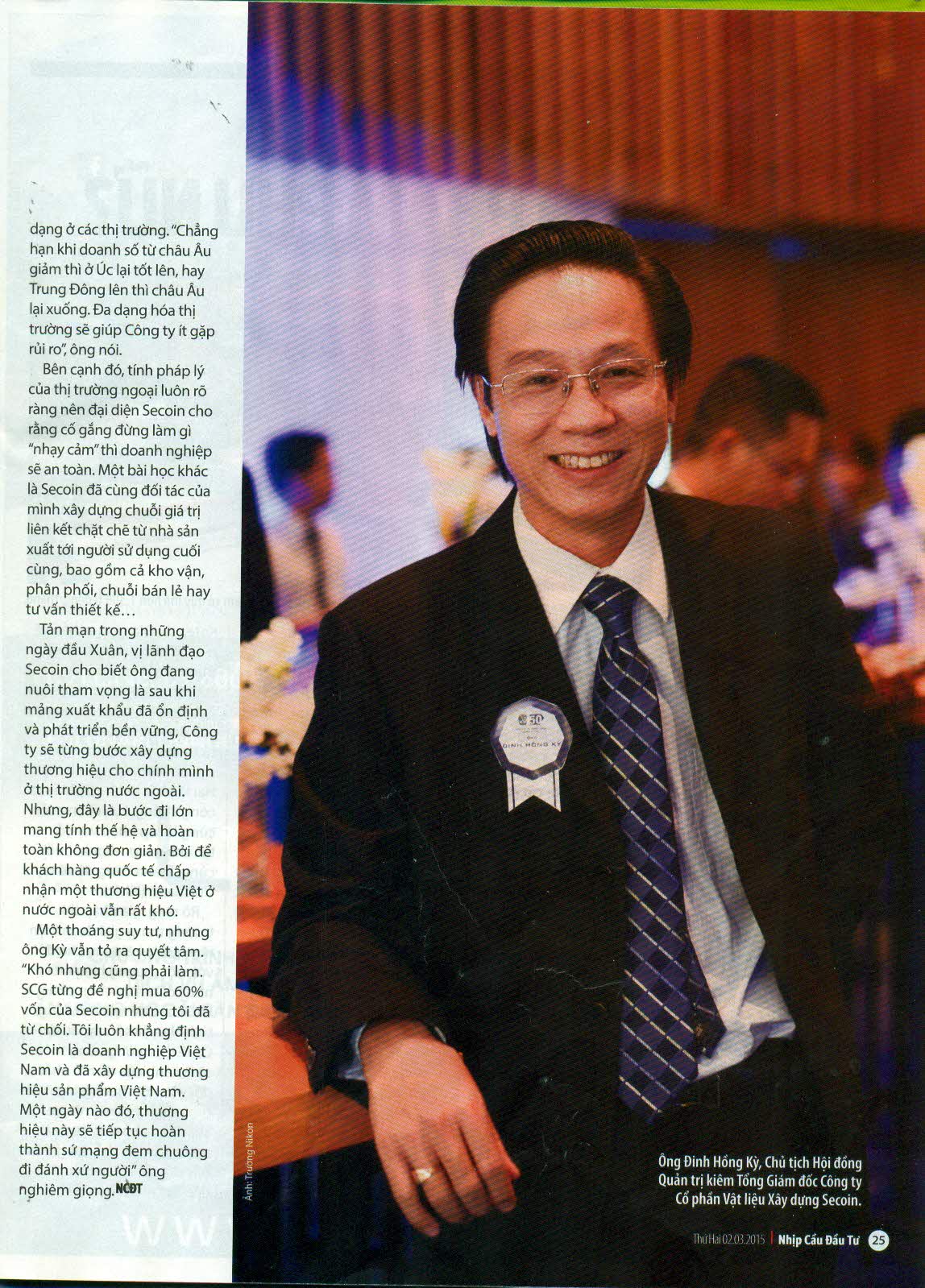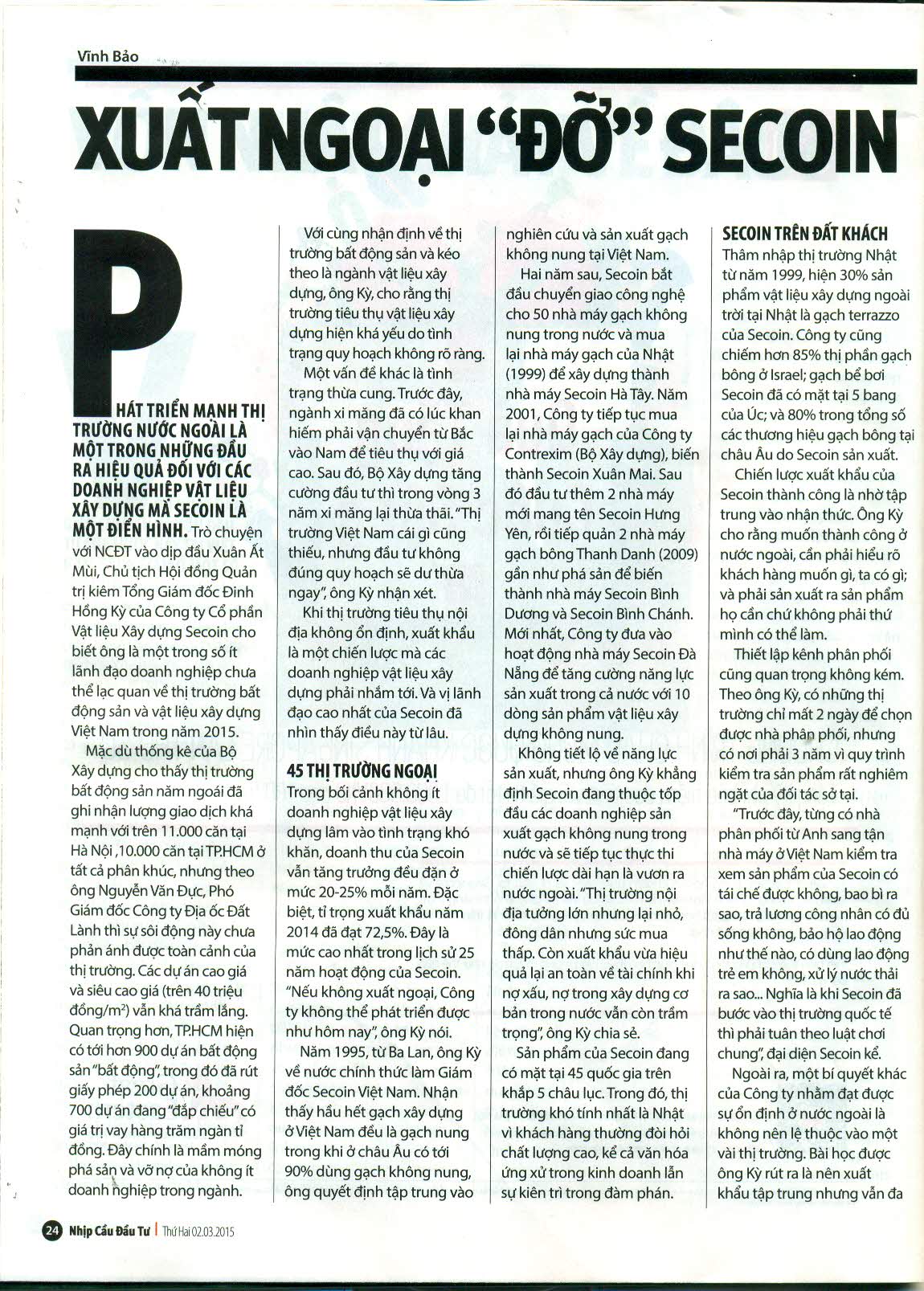The international market has served as a vital support, helping Secoin — a domestic construction materials company — overcome the challenges of the local market.



Strong Development of Overseas Markets as a Key Outlet for Building Material Enterprises, with Secoin as a Prime Example.
In an early Spring conversation with Nhãn hiệu & Đầu tư magazine, Mr. Đinh Hồng Kỳ – Chairman and CEO of Secoin Building Materials Corporation – shared that he remains one of the few business leaders who cannot be optimistic about Vietnam’s real estate and construction material markets in 2015.
Although statistics from the Ministry of Construction showed over 11,000 transactions in Hanoi and 10,000 in Ho Chi Minh City across all market segments last year, Mr. Nguyễn Văn Đực, Deputy Director of Đất Lành Real Estate Company, argued this activity does not reflect the overall market. High-end and luxury projects (over 40 million VND/m²) remain quiet. More importantly, HCMC has over 900 “stagnant” real estate projects, with licenses revoked for 200 and roughly 700 on hold, involving hundreds of trillions of dong in loans. This poses a high bankruptcy risk for many businesses.
Sharing this view, Mr. Kỳ believes that demand for construction materials is weak due to unclear urban planning.
Another issue is oversupply. Cement was once in short supply and shipped from North to South at high prices. But after heavy investment by the Ministry of Construction, surplus followed in just three years. “In Vietnam, everything seems scarce at first, but without proper planning, we quickly face surplus,” Mr. Kỳ remarked.
Facing unstable domestic consumption, exports have become a vital strategy for construction material enterprises. Mr. Kỳ recognized this long ago.
45 International Markets
While many companies struggle, Secoin has maintained steady annual growth of 20–25%. In 2014, export revenue reached a record 72.5%—the highest in the company’s 25-year history. “Without exports, we wouldn’t be where we are today,” said Mr. Kỳ.
In 1995, after returning from Poland, Mr. Kỳ officially became Director of Secoin Vietnam. He noted that most bricks in Vietnam were fired clay, while in Europe, 90% were non-fired. He decided to focus on producing non-fired bricks in Vietnam.
By 1997, Secoin had transferred technology to 50 non-fired brick factories. In 1999, the company acquired a Japanese factory, turning it into Secoin Hà Tây. In 2001, it acquired Contrexim’s plant (under the Ministry of Construction) and transformed it into Secoin Xuân Mai. More plants followed: Secoin Hưng Yên, Secoin Bình Dương and Bình Chánh (formerly Thanh Danh), and most recently Secoin Đà Nẵng, bringing its total to 10 non-fired building material product lines nationwide.
Without disclosing production capacity, Mr. Kỳ affirms Secoin is a top-tier non-fired brick producer in Vietnam, committed to long-term international expansion. “Vietnam’s domestic market looks large but isn’t. Despite a big population, purchasing power is low. Exporting is more efficient and financially safer given the lingering local bad debt and public construction debt,” he said.
Secoin products are now present in 45 countries across five continents. Among them, Japan is the most demanding market in terms of product quality and business etiquette.
Secoin Abroad
Entering Japan in 1999, today, 30% of its outdoor construction material market uses Secoin terrazzo tiles. The company holds over 85% of the encaustic cement tile market in Israel. Its pool tiles are sold in five Australian states, and 80% of European cement tile brands are manufactured by Secoin.
Secoin’s export strategy is rooted in deep customer insight. Mr. Kỳ believes success abroad requires understanding customer needs, leveraging core competencies, and creating what the customer wants—not just what you can produce.
Distribution is equally vital. Some markets take two days to finalize a distributor; others take up to three years due to rigorous testing requirements.
“In the past, a UK distributor flew to our Vietnam factory to inspect whether our tiles were recyclable, how we package, whether worker wages were livable, if we used child labor, and how we treated wastewater. Once you enter the global market, you must play by global rules,” said a Secoin representative.
Another success factor is diversification. Mr. Kỳ warns against relying on just a few markets: “When Europe is down, Australia is up, or when the Middle East is growing, Europe might be slowing. Diversifying markets reduces risk.”
He also notes that clear legal systems abroad keep businesses safe as long as they avoid “sensitive” issues. Secoin has also worked closely with partners to build integrated value chains—covering production, logistics, distribution, retail, and design consultancy.
Reflecting on these early Spring thoughts, Mr. Kỳ shared his ambition: once exports stabilize, Secoin will gradually build its own brand abroad. But this generational challenge won’t be easy—gaining international recognition for a Vietnamese brand is tough.
Still, he remains determined. “It’s difficult, but we must do it. SCG once offered to buy 60% of Secoin, but I declined. I always affirm: Secoin is a Vietnamese company with a Vietnamese brand. One day, it will fulfill its mission of ‘carrying the bell to ring abroad,’” he said firmly.
http://nhipcaudautu.vn/thi-truong/hang-hoa/xuat-ngoai-do-secoin-3244183/


